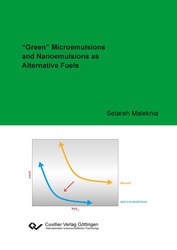| Fachbereiche | |
|---|---|
| Buchreihen (96) |
1378
|
| Nachhaltigkeit |
3
|
| Gesundheitswesen |
1
|
| Geisteswissenschaften |
2364
|
| Naturwissenschaften |
5406
|
| Mathematik | 229 |
| Informatik | 319 |
| Physik | 980 |
| Chemie | 1363 |
| Geowissenschaften | 131 |
| Humanmedizin | 243 |
| Zahn-, Mund- und Kieferheilkunde | 10 |
| Veterinärmedizin | 108 |
| Pharmazie | 147 |
| Biologie | 835 |
| Biochemie, Molekularbiologie, Gentechnologie | 121 |
| Biophysik | 25 |
| Ernährungs- und Haushaltswissenschaften | 45 |
| Land- und Agrarwissenschaften | 1004 |
| Forstwissenschaften | 201 |
| Gartenbauwissenschaft | 20 |
| Umweltforschung, Ökologie und Landespflege | 148 |
| Ingenieurwissenschaften |
1793
|
| Allgemein |
98
|
|
Leitlinien Unfallchirurgie
5. Auflage bestellen |
|
Erweiterte Suche
“Green” Microemulsions and Nanoemulsions as Alternative Fuels
Setareh Maleknia (Autor)Vorschau
Inhaltsverzeichnis, PDF (670 KB)
Leseprobe, PDF (860 KB)
Combustion of water-containing diesel fuels results in a simultaneous reduction of soot and NOx-emissions, i.e. they partially avoid the so-called soot-NOx trade-off. In the frame of the present work new temperature invariant, highly efficient fuel microemulsions of the type water/antifreeze – diesel fuel – oleic acid/monoethanolamine/oleic acid diethanolamide containing up to 24 wt.% water with appropriate physical characteristics for commercial applications were formulated. As unexpected reward of the investigations on formulation of microemulsion fuels, novel water-in-fuel nanoemulsions (< 200 nm) were obtained featuring substantial reduction of surfactant content, an interesting economical aspect. Exhaust gas emissions, soot-structure and size distribution of water containing fuels compared to pure diesel fuel were analysed. The results show that using load-dependent water containing fuels yield a drastic reduction of soot up to 98 % (FSN) as well as nitrogen oxide emissions up to 62 %.
| ISBN-13 (Printausgabe) | 9783954049127 |
| ISBN-13 (E-Book) | 9783736949126 |
| Buchendformat | A5 |
| Sprache | Englisch |
| Seitenanzahl | 216 |
| Umschlagkaschierung | glänzend |
| Auflage | 1. |
| Erscheinungsort | Göttingen |
| Promotionsort | Köln |
| Erscheinungsdatum | 13.01.2015 |
| Allgemeine Einordnung | Dissertation |
| Fachbereiche |
Physikalische Chemie
|
| Schlagwörter | Microemulsionen, Nanoemulsionen, alternative Kraftstoffe, Schadstoffreduzierung, Biokraftstoff, Ruß-NOx trade off, Tenside, Schmierfähigkeit, DIN 590, Kinetik, Dynamische Lichtstreuung, Additive |








